One day in the woodshop… I was applying a finish to a newly constructed coffee table and I activated my fume control system. This involves opening one of the windows and turning on a fan that is positioned in front of the window to blow fume-laden air outside. It actually works fairly well at clearing the air but this time I was a bit forgetful and left the window open for an entire day. ( I generally close it within a few hours after most of the fumes have dissipated). Unfortunately, it was the middle of the summer and the humidity was high. This resulted in massive condensation on the HVAC ducts running through the woodshop ceiling (it’s a basement shop), eventually leading to water drips, one of which was right above the jointer. By the time I became aware of the situation, the damage was done and the outfeed table of the jointer had a nasty rust stain.
After attending to the open window and drying off the remaining condensation on the ducts, I launched into rust removal mode. The first thing I did was to scrape off the rust “crust” with a wire brush and an old putty scraper, followed up with a drill-powered wire wheel brush. This removed the bulk of the rust build-up but a pronounced rust stain was still present. The before photo shown below was taken at this stage.
Quick note: It’s important to remove rust from power tools for a number reasons. For one, rust can inhibit the sliding movement of stock on table surfaces – especially table saws and jointers. For another, you don’t want rust stains on the wood or affecting the wood finish. Finally, once rust gets a foothold, it becomes easier for it to continue growing. I read somewhere that this is because iron oxide (the rust molecule) is a larger molecule than iron so when iron/steel rusts, it “puffs” up, exposing more bare metal to damaging oxygen in the air. This allows rusting to progress until it eats up all the solid iron.
Rust Stain Removal
Phase 2 of the rust removal operation was to take care of the rust stain. For this, I opted for good old-fashioned naval jelly. Yes, that pink goop that smells somewhat like rotten eggs. You brush it on, let it sit for 5-10 minutes, and then remove with fresh water. Repeat until the rust is gone. That’s the basic method for applying naval jelly although I modified the approach slightly to deal with my rust stain.
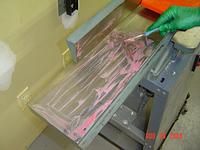 Applying naval jelly to rust |
Using an old toothbrush, I brushed on a liberal amount of naval jelly to cover not only the rust stain but the entire outfeed table. This is because naval jelly slightly changes the color of the metal so any uncovered areas will stand out like a sore thumb. When working with naval jelly, it is important to work in a well-ventilated area and to wear safety gloves. | |
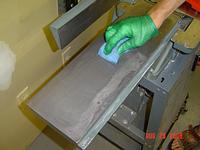 Applying naval jelly – always wear protective gloves! |
After about 10 minutes, I scrubbed the rust stain with a toothbrush and a nylon scrub sponge. I applied the most elbow grease to the actual stain but also made it a point to make passes over the entire work area to minimize streaking (yes, the acid in naval jelly will cause streaking if you leave it on too long). | |
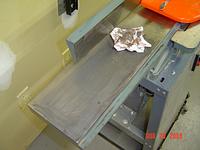 Wiping off rust and naval jelly residue |
I removed the residue with a wet sponge and paper towels. Note how black it is – see below for an explanation. A second coat of naval jelly was applied and scrubbed after about 5 minutes (not quite as long as the first coat). I was careful not to allow the naval jelly to linger too long on painted surfaces because it will remove paint. Oohhh, this stuff smells! | |
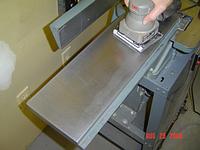 Sanding off residual rust |
After thoroughly wiping off the naval jelly residue, the rust stain was still obvious but no longer had a reddish-brown color. I decided to use a palm sander for a final smoothing. I made two passes – one with 150-grit and one with 220-grit. It’s important to sand the entire surface so swirl marks won’t be so noticeable. |
The final step was to apply a little Top-Cote to the jointer surfaces. This is a spray-on coating that protects metal against corrosion and also acts as a lubricant so wood slides freely. A similar rust inhibitor/lubricant product is Top Saver. Furniture paste wax also works (but don’t use auto paste waxes because they may contain silicon and that’s not good for wood finishes).
An Aside on Naval Jelly
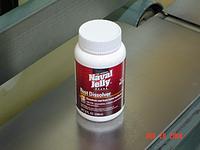
Naval jelly
The active ingredient in naval jelly is phosphoric acid, a powerful chemical that converts rust directly to a water soluble phosphate compound called iron phosphate. This compound is black in color and can be wiped off with plain water. It actually provides a certain degree of corrosion resistance although I don’t think too many woodworkers would go for having a messy, black substance on their tools. (Maybe it’s not so messy after it dries?)
As mentioned above, naval jelly emits a strong smell so work in a well-ventilated area and don’t breath too deeply. Also, the phosphoric acid in it actually etches the metal so don’t leave it on any longer than necessary (although it’s not nearly as corrosive as other acids like hydrochloric or oxalic acid). If rust is really built up, remove as much as possible via mechanical means (scraping, brushing, sanding, rubbing) before applying naval jelly. Otherwise, the jelly will only attack the surface rust – turning into relatively inert iron phosphate – and won’t penetrate to the deeper rust layers.


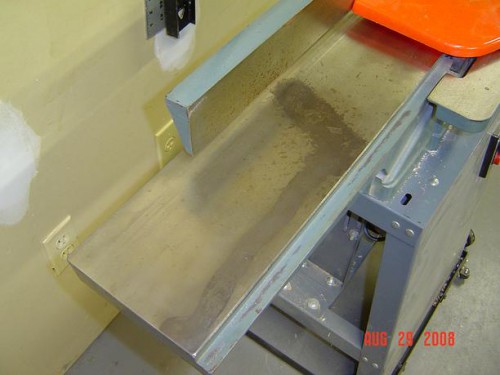
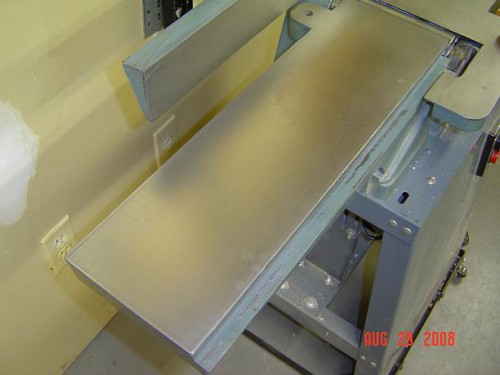
I think Rust Stain Remover stage is the most difficult stage. I do not have the instruments like you. I think I have to use other tools to complete it. thank you for this excellent ideas.